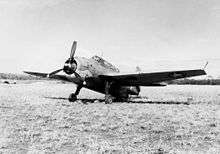VMA-131
| Marine Attack Squadron 131 | |
|---|---|
|
VMA-131 Insignia | |
| Active |
March 1919 - November 16, 1945 Unk - December 5, 1998 |
| Country | United States |
| Allegiance | United States of America |
| Branch | United States Marine Corps |
| Type | Attack Squadron |
| Role |
Close air support Air interdiction |
| Part of | Inactive |
| Nickname(s) | Diamondbacks |
| Tail Code | QG |
| Engagements |
Banana Wars * Dominican Republican World War II * Battle of Guadalcanal * Battle of Okinawa |
| Aircraft flown | |
| Attack | A-4 Skyhawk |
| Bomber |
O3U-6 Corsair Great Lakes BG (1939-41) SB2U-3 Vindicator SBD Dauntless TBM Avenger |
Marine Attack Squadron 131 (VMA-131) was an A-4 Skyhawk attack squadron in the United States Marine Corps. The squadron, also known as the “Diamondbacks”, were part of the Marine Forces Reserve and were based at Naval Air Station New York, Brooklyn, New York from 1960 through 1972 and NASJRB Willow Grove from 1972 until their deactivation in 1998.
History
Early years
The squadron was formed as the 1st Air Squadron in Santo Domingo, Dominican Republic in March 1919. They were redesignated VO-4M on May 29, 1922 and returned to Marine Corps Base Quantico in 1924. The squadron was again redesignated as VO-7M on July 1, 1927. Ten years later on July 1, 1937 the squadron again changed names, this time to Marine Scouting Squadron 1 (VMS-1). Exactly four years later saw a fifth name change to Marine Scout-Bomber Squadron 131 (VMSB-131).
World War II
Following the attack on Pearl Harbor the squadron was ordered to San Diego, California. After months of training, the squadron left San Francisco on September 6, 1942 on board the USS Mount Vernon heading for Marine Corps Air Station Ewa, Hawaii. In November 1942, the squadron was reorganized as the first Marine torpedo bombing squadron and sent to Henderson Field and Espiritu Santo to become part of the Cactus Air Force during the Battle of Guadalcanal.


During the fighting crews and pilots rotated between these two bases. The squadron was relieved on February 18, 1943 but rejoined the fighting in April 1943. During its time on Guadalcanal, VMSB-131 scored 14 sure hits and 6 probables with its torpedoes against Japanese shipping. They also scored 6 direct hits against ships with bombs. All this came at a cost of 8 pilots and 17 radiomen and gunners killed in action. For their efforts six pilots were awarded the Distinguished Flying Cross for heroism.[1] The squadron finally left the combat zone and returned to Marine Corps Air Station El Toro in June 1943 and were redesignated Marine Torpedo Bombing Squadron 131 VMTB-131.
After a year of rest, refitting, and training, VMTB-131 again deployed to the Pacific Theater on March 29, 1944 this time on board the USS Petrof Bay. They finally arrived in Guam in August 1944 and flew anti-submarine patrols for the next eight months. On April 27, 1945 the squadron was attached to Marine Aircraft Group 22 (MAG-22) and departed for Okinawa. During the Battle of Okinawa they were based out of Ie Shima, an island just to the northwest of Okinawa, and continued to fly anti-submarine patrols and also provided close air support for American ground forces. On July 25, 1945 they were transferred under the command of Marine Aircraft Group 14 (MAG-14) and went ashore to be based out of Okinawa where they remained until the end of the war. The squadron returned to the west coast and were deactivated on November 16, 1945.
Reserve years

Following World War II, the squadron became part of the Marine Air Reserve and were based out of Naval Air Station New York, Brooklyn, New York from 1960 through 1972 and NASJRB Willow Grove from 1972 until 1998. On January 12, 1990 an A-4 Skyhawk from the squadron crashed on approach to NAS Willow Grove, coming down in Upper Moreland Township, impacting in an intersection, with debris tearing off the roof of an auto-leasing business, destroying four cars and damaging six houses with no injuries on the ground. The pilot parachuted into tree nearby suffering only minor injuries.[2]
- On June 22, 1994 the squadron officially retired its last A-4M aircraft. Four pilots flew a short flight that included a flyby the field. Aside from the various Marines from the squadron and MAG-49, there were family and invited guests. The pilots were:
Col. George "Eagle" Lake III CO VMA-131 Major John "Baja" Rufo XO VMA-131 Captain Dave "Yoda" Hurston Major Mike "Struts" Volland VMA-131 Ops Officer
- In December 1998, VMA-131 stood down as a squadron, LtCol. Volland the last Squadron Commander at the time.
See also
References
- Notes
- ↑ Hubler, Flying Leathernecks, p.124.
- ↑ Pilot Survives Crash of Jet In a Suburb of Philadelphia
- Bibliography
- Hubler, Richard G.; Dechant, John A (1944). Flying Leathernecks - The Complete Record of Marine Corps Aviation in Action 1941 - 1944. Garden City, New York: Doubleday, Doran & Co., Inc.
- Rottman, Gordon L. (2002). U.S. Marine Corps World War II Order of Battle - Ground and Air Units in the Pacific War, 1939 - 1945.’’. Greenwood Press. ISBN 0-313-31906-5.
- Sherrod, Robert (1952). History of Marine Corps Aviation in World War II. Washington, D.C.: Combat Forces Press.
- Web

